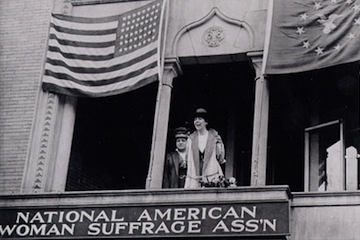The National Woman Suffrage Association and the American Woman Suffrage Association
Shortly after the Civil War, there was a seismic split in the women's suffrage movement. It involved every big name in the movement, and resulted in two rival organizations. Susan B. Anthony and Elizabeth Cady Stanton founded the National Woman Suffrage Association (NWSA), while Lucy Stone, Henry Blackwell, and Julia Ward Howe created the American Woman Suffrage Association (AWSA). The two organizations operated independently, with some antagonism, until they reunified in 1890. The resulting national organization, the National American Woman Suffrage Association (NAWSA), became the most prominent voice of the movement and greatly expanded its influence. The division and reconciliation were mostly driven by arguments about strategy -- different leaders had different ideas on what to advocate for, and how.
Of the two groups, the National Woman Suffrage Association was more aggressive in its tactics and demands. The immediate cause of the split was the Fifteenth Amendment, which granted freed slaves (freedmen only) the right to vote. Susan B. Anthony and Elizabeth Cady Stanton had advocated for the voting rights of both freed slaves and women. They did not support the passage of the Fifteenth Amendment as long as it included men only. They also took a more radical stance on other issues such as divorce laws and labor conditions for women. Finally, they focused on the passage of a national Amendment as opposed to changes at the state level. The NWSA also did not permit men in leadership roles.
The American Woman Suffrage Association was more incremental and conservative in its tactics. It included men in its leadership, such as Henry Blackwell, to maintain closer ties to the political world. It thought the Fifteenth Amendment was important enough to be passed independent of woman's suffrage. It limited its focus entirely to woman's suffrage and did not address other political issues. It also focused on passing legislation at the state level, believing that the issue could slowly ascend to national importance if enough states took up the cause.
By the 1880s, the strengths and weaknesses of each approach had become apparent. Even Susan B. Anthony herself began to cast aside other issues in favor of a singular focus on women's suffrage. Younger activists were removed from the 1869 split and did not think the issues behind it were relevant, and saw the division between the two organizations as a matter of personality conflicts. Many in the movement began to think that progress would never be made with such a diffusion of efforts, and the best positions of the two groups were finally consolidated into the NAWSA, of which Elizabeth Cady Stanton served as the first President. She was soon followed by Susan B. Anthony.
This reconciliation pointed to the strategies that would be used to drive women's suffrage into the political mainstream. Activists took advantage of a growing women's club movement to draw many thousands of new women into their orbit. They branded women's suffrage as a moderate, non-controversial cause by decoupling it from other radical causes of the day. For instance, the NAWSA downplayed its support from blacks and did not publicize its black female membership (particularly important if the essential support of any Southern states was to be secured for an Amendment). It also supported any politician of either party who supported women's suffrage, and did not take a position on the controversial political issues of the day. Susan B. Anthony herself was lionized as a grandmotherly figure of the movement, and many of her earlier controversies and positions were whitewashed. In all of these ways, NAWSA sought to make the support of women's suffrage a socially acceptable position, which could translate into action on the part of national politicians in the House and Senate.
Of course, the final story is a bit more complicated. Activists such as Alice Paul implemented much more aggressive tactics by the 1910s. Suffragette marches were attacked by mobs, and the conflicts drew in police and sensational headlines. Many women picketed the White House, starting in 1917, as the Silent Sentinels, and were beaten and abused by authorities. Perhaps the Nineteenth Amendment would have happened anyway, or perhaps the strategy of the NAWSA would have reached it limits. The questions about tactics, and which tactics were most effective in influencing and changing, as opposed to alienating the general public, would persist until ratification and have applied to many subsequent movements besides women's suffrage.
